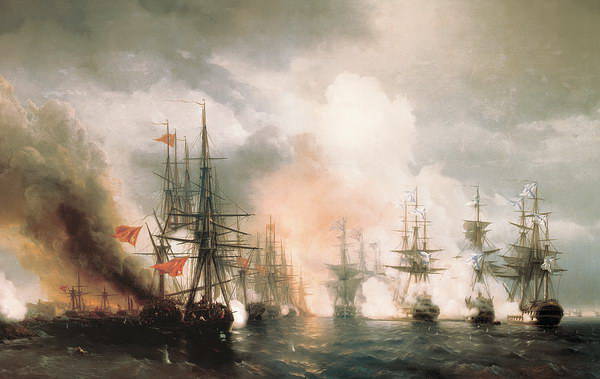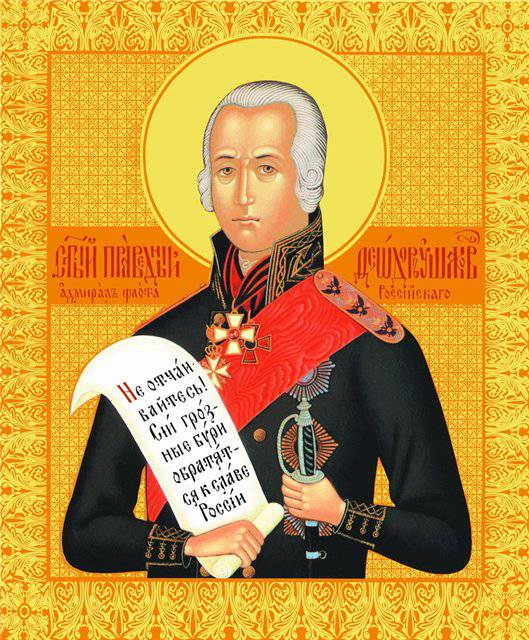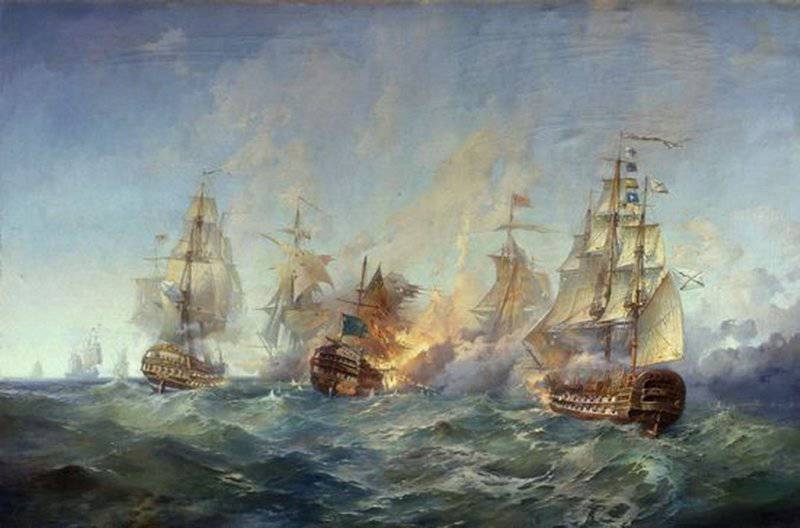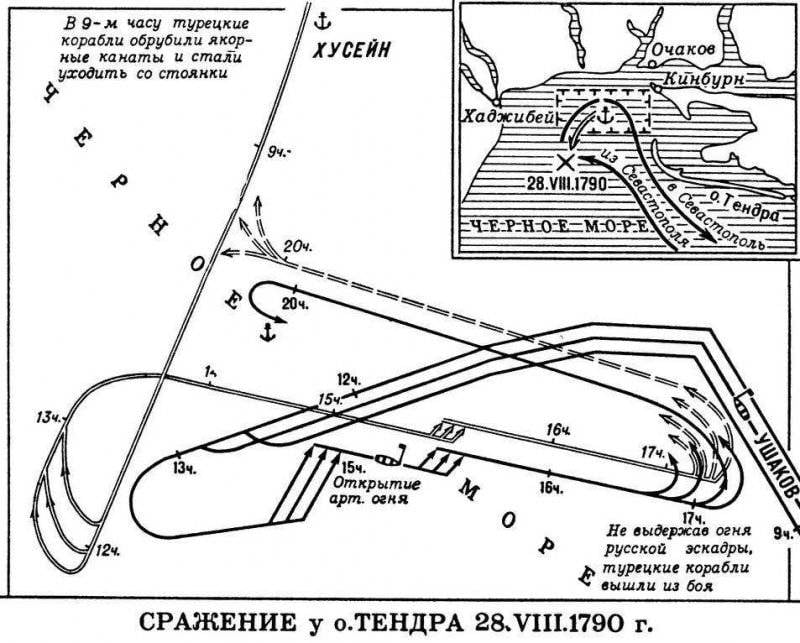Day of Military Glory of Russia - Victory of the Russian squadron at Cape Tendra (1790)
One of the days of Russian military glory, celebrated on September 11, is the Victory Day of the Russian squadron under the command of F.F. Ushakov over the Turkish squadron at Cape Tendra. This event refers to the period of the Russian-Turkish war (1787-91) caused by the revanchist plans of the Ottoman Empire, which, with the support of England and Prussia, demanded the return of Crimea, recognition of Georgia by the regime of passage of Russian merchant ships through the Black Sea straits.
By the beginning of the war, the balance of forces at sea was clearly not in Russia's favor. Against 40 Turkish battleships and frigates, the Black Sea Fleet could set a little more than 20. In addition, the Turks had French-built ships, sheathed in copper, which had better speed than the Russians. Lost Russian ships and displacement, number and caliber of guns. In the military campaigns of 1787-89. Turkey did not achieve the desired result. Moreover, in the land direction in the battles of Fokshany and Rymnik, the Turks suffered a crushing defeat from the Russian-Austrian troops. At sea in May 1788, the Sevastopol squadron under the command of Rear Admiral Ushakov defeated the fleet the enemy off the island of Fidonisi, and in June the Liman flotilla defeated the forces of the Turkish fleet in the Dnieper estuary. But the numerical superiority of the fleet remained with the Ottoman Empire. Given this and counting on the support of England and Prussia, Turkey intended to continue the war, focusing its main efforts on the sea.
The Turkish plan included a strike on the Caucasian coast of the Black Sea and the occupation of the Crimea. 14 March 1790. Rear Admiral FF was appointed Commander of the Black Sea Fleet. Ushakov. He understood that the inequality of forces in the Black Sea did not promise true success when using strict canons of naval combat by ships in the battle line - the requirements of the so-called linear tactics generally accepted at that time in all the fleets of the world. There was a need to search for new tactics. Its main principles, worked out by Ushakov, denied the blind obedience of the battle line. The naval commander, in his opinion, at the beginning of the battle should have focused his efforts on the weakest part of his formation. The Turks had such a flagship, with the defeat of which the structure of the Turkish ships crumbled, they fled. In addition, Ushakov believed that in battle, a strong reserve of moving ships (frigates) was needed. During the battle, the naval commander should not lose favorable positions (“useful cases” - hesitations, confusions, mistakes of the enemy) and use them for successful actions; the commanders of the ships also should not miss “useful cases”. They represented a certain share of independence.
The first results of the new tactic gave 8 July in the battle of the Kerch Strait, where, despite the numerical superiority, the Turkish fleet was defeated. The plan of capture by the Turkish landing force of the Crimea was foiled. But the sea power of the Ottoman Empire was not completely undermined. In early August, the Turkish fleet scattered all over the sea again began to gather in a single squadron near the mouth of the Dnieper estuary in 10 miles from the coast. The commander of the Turkish fleet capud-pasha (admiral) Huseyn (Huseyn) was eager for revenge for the defeat at the Kerch Strait. To help him, the Turkish Sultan Selim III sent an experienced junior flagship - Seyid Bey.
The situation on the land direction also prompted Ushakov to promptly eliminate the danger from the sea. Russian troops advancing in the direction of the mouth of the Danube, needed support from the sea and relied on the assistance of the fleet. But Ushakov was in no hurry to go to sea, because by tying up a battle with one of the formations of the Turkish fleet, he risked exposing Sevastopol to the dangers of attacking other detachments. Therefore, waiting for the concentration of all the forces of the Turkish fleet for the general battle.
On the morning of August 21, the main part of the Turkish fleet (45 ships) moved to the anchorage area between Haji Bey (Odessa) and Cape Tendra. Huseyn Pasha believed that the Russian squadron did not have time to recover from the previous battle and should not expect it to leave Sevastopol anytime soon. But the Russians, quickly eliminated the damage to the ships, and Ushakov August 25 brought them to sea. At dawn 28 August 1790 - the Russian squadron of Ushakov suddenly appeared in the area of the Turkish fleet stationed at Tendra. It was inferior to the enemy: 10 battleships (of which only 5 is large), 6 frigates, 1 bomber ship and 20 auxiliary ships against 14 large battleships, 8 frigates and 23 auxiliary ships.

But on the Russians' side were surprise and advantageous position relative to the direction of the wind. The Turks, who did not expect the attack, began to cut down the anchor lines in a hurry and retreat to the mouth of the Danube. Ushakov ordered "carry all the sails." The advanced Turkish ships managed to retire a considerable distance, but the swift maneuver of the Russian squadron threatened to cut off their other ships. Through the efforts of Kapudan Pasha and especially Seid Bey, the Turks managed to overcome confusion and organize resistance. In order to cover up his rear guard, the Turkish commander turned to the right tack and hastily began to build ships in the wake column for battle on a head-on course. A Russian ships, having made a difficult maneuver, lay down on a course parallel to the enemy fleet. Using a tactical device that proved itself in the Kerch battle, Ushakov brought three frigates “Ioan Warrior”, “Jerome” and “The Protection of the Virgin” out of the line to provide maneuvering reserve in case of a wind change and a possible change in the direction of the enemy’s attack. In 15 hours, approaching the distance of the shot shot, the Russian ships opened fire. The main blow of their main forces was aimed at the Turkish avant-garde, where there were Turkish flagship ships. Ushakov’s flagship “Christmas” fought a battle with three ships at once, forcing them to get out of line. After two hours of brutal duels, the rest of the Turkish ships, unable to withstand the fire, began to turn away into the wind and get out of the battle in disarray. But during the turn, a series of powerful volleys fell upon them, leading to great destruction. Two flagship Turkish ships, which were against the “Nativity of Christ” and the “Transfiguration of the Lord”, suffered particularly.
Turks' confusion increased. Ushakov continued chasing the younger flagship ship. Russian ships followed the lead of their leader. 3 Turkish ship were cut off from the main forces, but the advance of the night saved the Turkish fleet. Ushakov’s squadron ships anchored to repair damage. Seeing at dawn 29 August, the Turkish fleet stationed not far away, Ushakov ordered to immediately remove from the anchor and attack him. The Turks, not having time to recover from the recent battle, decided to flee. In pursuit of them, the Russian squadron forced the delivery of the 66-gun ship "Melekhi Bahri" and the 74-gun ship of the younger Turkish flagship "Kapudanie", which by the time of delivery was burning and soon exploded. The entire 20 man was saved and captured, including Admiral Seyd Bey. On the way to the Bosphorus, due to damage, another 74 gun ship and several smaller ships sank. In addition, the enemy lost two more small vessels and a stranded floating battery. In the reports to the sultan, the Turkish flagships wrote that the number of dead and wounded "stretches" to 5500 people. The Russians lost their dead and wounded 46 people.

The victory of the Black Sea Fleet at Tendre was complete, made a significant contribution to the outcome of the war, allowed to clear the north-western part of the Black Sea from enemy ships and opened a free exit for the ships of the Liman flotilla to the sea. As a result, with the assistance of the Russian flotilla that had entered the Danube, Russian troops took the fortresses of Kiliya, Tulcha, Isacchi and, finally, Izmail. Tendra inscribed in history world naval art. Admiral Ushakov became one of the first Russian flagships recognized by Europe, and an innovator of the maneuverable tactics of naval combat, which justified itself in battle, led to the destruction of Turkish domination on the Black Sea and confirmed the position of Russia on its shores.


Information